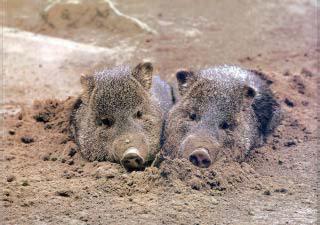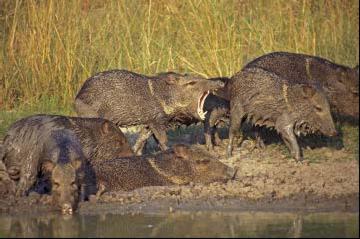
|
 Collared Peccary


Peccaries live in herds, where they eat, sleep & forage together. |
The collared peccaries, (Tayassu
tajacu) also known by its Spanish name,
javelina or pecarí are medium-sized
mammals of the family Tayassuidae.
Peccaries are members of the Artiodactyls
(even-toed ungulants). They are
found in the southwestern area of North
America and throughout Central and
South America.
Peccaries usually measure between
90 and 130 centimeters in length (three
to four feet), and a full-grown adult
usuRojo Loungeally weighs between
about 20 and about 40 kilograms (44 to
88 pounds). Collared Peccaries are
often confused with pigs due to their
appearance. Their coat is a grizzled
grayish black throughout, except for a
yellowish tinge on the cheeks and a
whitish to yellowish collar extending
the mane, over the shoulders, and to
the throat. While males and females
are very similar in size and color, young
are a yellowish brown color, with a
black stripe down the back. Collared
Peccaries have short, straight tusks that
fit together tightly enough to hone each
other down with every jaw movement.
This razor sharpness gives this species
its common name: Javelina: a javelin
is a lightweight, tip-shaped spear. Javelinas
have a distinct dorsal gland on
the rump that is essential in much species-
specific behavior. They also have
poor eyesight and good hearing, which
are believed to contribute to the very
vocal nature of this species. Peccaries
have large scent glands on their backs
towards their rumps from which they
secrete an oily musk with a strong,
pungent smell.

One to three, but rarely four, young are born after a gestation period of 141 to
151 days. Birthing mothers retreat from the group; the newborn might otherwise
be eaten by other group members |
A designated or specific breeding
season does not prevail in Collared
Peccary herds; rather, mating reflects
climate, especially rain, and occurs
throughout the year. More young are
raised in rainy years. The dominant
male does virtually all the breeding.
Subordinate males do not have to leave
the herd, but are not allowed to approach
females in estrus. As a result,
bachelor herds do not exist. One to
three, but rarely four, young are born
after a gestation period of 141 to 151
days. Birthing mothers retreat from the
group; the newborn might otherwise be
eaten by other group members. However, mothers rejoin the herd one day
after giving birth. Only the older sisters
of the newborn are tolerated with
the young; these often become nursemaids
for the new mother. Weaning
occurs at two to three months. Males
reach sexual maturity at eleven
months; females, at eight to 14 months.
Collared Peccary Continued from Page 6
Despite the high mortality rate in this
species, members have a life span of
up to 24 years, which was observed in
captivity. Peccaries have very close
social relationships; they live in herds
of 5 to 15 that are notably cohesive;
members eat, sleep, and forage together.
The exceptions are the old and
infirm, who prefer to die in solitude.
Herds have a characteristic linear
dominance hierarchy, wherein a male
is always dominant and the remainder
of the order is largely determined by
size. Territories range in size from 6
to 1260 hectares, and depend on herd
size and food availability. Territories
are defended by the rubbing of the rump
oil gland against rocks, tree trunks, and
stumps; this leaves smears of an oily
fluid as a marker. Both sexes actively
defend the home range. Collared peccaries
fend off adversaries by squaring
off, laying back their ears, and clattering
their canines. In fight, they
charge head on, bite, and occasionally
lock jaws. The dorsal rump gland is
also used as recognition and identification.
In greeting, two group members
rub each other, head to rump.

The Collared Peccary is one of the most widespread of Amazon mammals.
They live in large herds of up to 50 individuals, foraging for a variety of food
including fruits, seeds, leaves and small animals. |
The Collared peccary is very dependent
on ambient temperature and
seasonal changes. This species is vocal;
several calls have been classified
into three categories: aggressive, submissive,
and alert. They are primarily
herbivorous, and have complex
stomachs for digesting coarsely- chewed food. In its southern range,
this species eats a variety of foods,
including roots, bulbs, fungi, and nuts,
in addition to fruits and occasional
eggs, carrion, snakes, fish, and frogs.
In the northern range, Collared Peccaries
eats more herbivorous foods,
such as roots, bulbs, beans, nuts, berries,
grass, and cacti. Despite all this
supplementary diet, the main dietary
components of this species are agaves
and prickly pears. The prickly
 pear is ideal in the Javelina’s arid
range due to its high water content.
This species is also capable of eating
cultivated crops. People often confuse
peccaries, which are found in the New
World, with pigs that originated in the
Old World, especially since some domestic
pigs brought by European settlers
have escaped over the years and
now run wild in many parts of the
United States. Unlike pigs, peccaries
only raise one or two young and the
piglets are able to run and follow the
mother soon after birth.
pear is ideal in the Javelina’s arid
range due to its high water content.
This species is also capable of eating
cultivated crops. People often confuse
peccaries, which are found in the New
World, with pigs that originated in the
Old World, especially since some domestic
pigs brought by European settlers
have escaped over the years and
now run wild in many parts of the
United States. Unlike pigs, peccaries
only raise one or two young and the
piglets are able to run and follow the
mother soon after birth.
The main predators of Collared
Peccaries are humans, coyotes, pumas,
jaguars, and bobcats. For centuries,
young Peccaries have been
captured, kept as domestic pets, and
even fattened by Central and South
American Indians. In Peru, 10,000
skins have been exported annually for
decades. In Texas, more than 20,000
individuals are shot during the hunting
season. Populations are fairly resilient
due to adaptability, although subspecies
in the tropics are threatened
by rainforest destruction.
Click here to return to the main page for Caribbean Critters
|


 pear is ideal in the Javelina’s arid
range due to its high water content.
This species is also capable of eating
cultivated crops. People often confuse
peccaries, which are found in the New
World, with pigs that originated in the
Old World, especially since some domestic
pigs brought by European settlers
have escaped over the years and
now run wild in many parts of the
United States. Unlike pigs, peccaries
only raise one or two young and the
piglets are able to run and follow the
mother soon after birth.
pear is ideal in the Javelina’s arid
range due to its high water content.
This species is also capable of eating
cultivated crops. People often confuse
peccaries, which are found in the New
World, with pigs that originated in the
Old World, especially since some domestic
pigs brought by European settlers
have escaped over the years and
now run wild in many parts of the
United States. Unlike pigs, peccaries
only raise one or two young and the
piglets are able to run and follow the
mother soon after birth.


